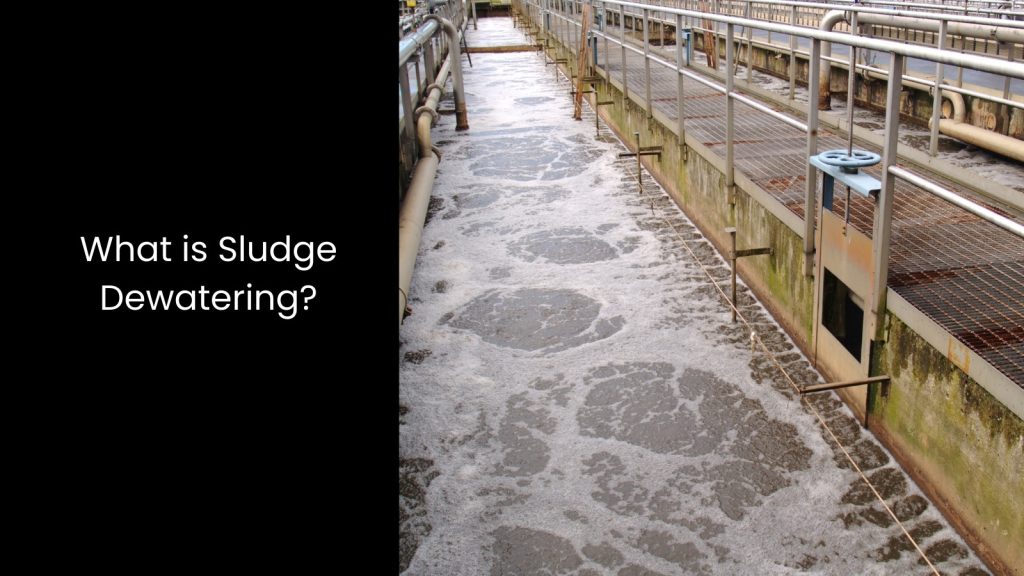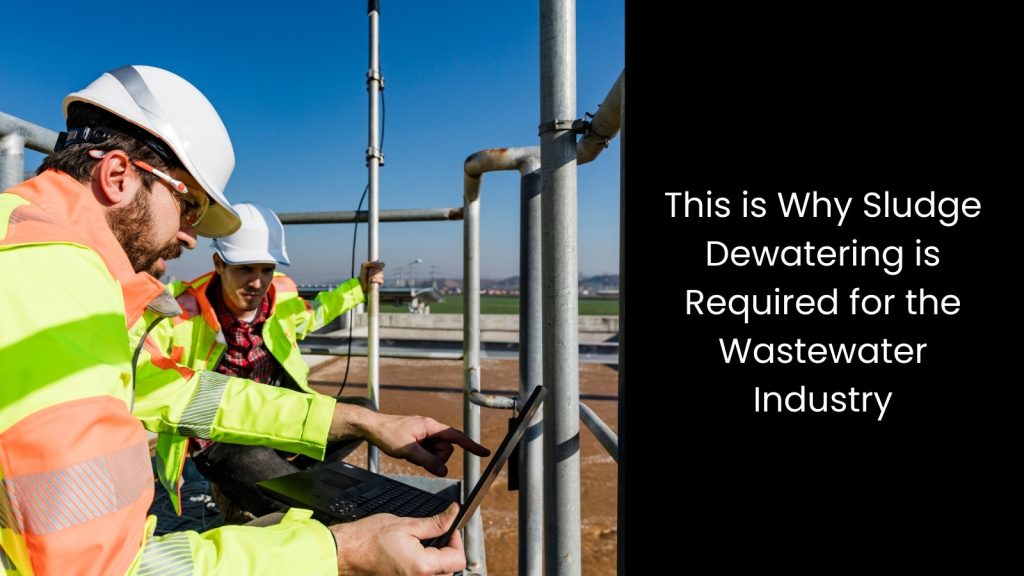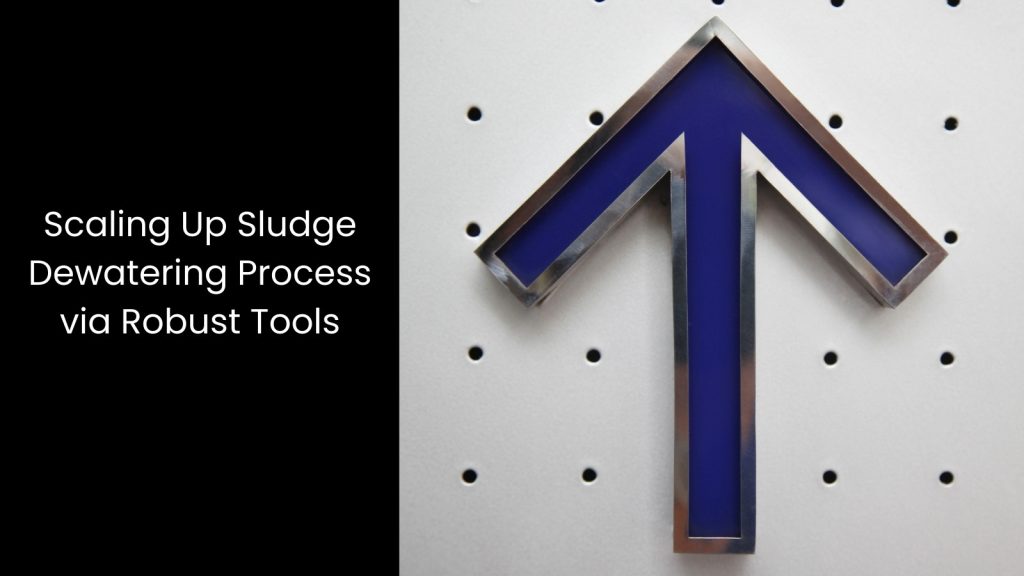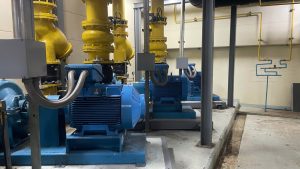Among the many processes in wastewater treatment, sludge dewatering has gained remarkable popularity over the years. As the wastewater industry faces growing challenges like environmental regulations, rising costs, and space limitations, this process stands out as a problem-solver for many wastewater treatment plants around the globe. As you know, sludge dewatering primarily focuses on removing excess water from sludge, reducing its volume and weight to make it easier to handle, transport, and dispose of. But its benefits go far beyond just practicality.
In this article, we uncover its importance for the wastewater industry in an operational ecosystem that targets efficiency and performance.
In this article, we uncover its importance for the wastewater industry in an operational ecosystem that targets efficiency and performance.
What is Sludge Dewatering?

- Sludge dewatering in the wastewater treatment industry is a process of removing water from sludge to reduce its volume and prepare it for disposal or reuse.
- This process is quite vital in managing wastewater efficiently as it transforms liquid sludge into a semi-solid or solid form with a higher concentration of solids. The method of sludge dewatering minimises transportation and disposal costs, ensures compliance with environmental regulations, and reduces the risk of water pollution.
- There are some techniques like belt filter presses, centrifuges, and screw presses in this process, which can help achieve optimal water removal. So, this dewatered sludge becomes easier to handle, store, and treat further, whether for energy recovery, nutrient extraction, or landfill disposal. The process also improves odour control and decreases the leachate produced during disposal.
- In industries prioritising sustainability, sludge dewatering supports resource recovery and energy-efficient operations. This is the main reason for considering the latter as a critical step in wastewater treatment strategies.
This is Why Sludge Dewatering is Required for the Wastewater Industry

Sludge Dewatering Facilitates Further Treatment
One of the many benefits of sludge dewatering is that it facilitates further wastewater treatment by transforming sludge into a more manageable form.
As you already know, dewatered sludge, with reduced water content and increased solids concentration, becomes easier to handle and process for additional treatment methods like composting, drying, or thermal treatment. Composting uses organic-rich dewatered sludge to create nutrient-rich compost, which can be used in agriculture, reducing waste and promoting sustainability.
This drying dewatered sludge further lowers moisture levels, making it lighter and more efficient for storage or transportation. Thermal treatment processes, such as incineration or gasification, convert dewatered sludge into energy or ash, ensuring safer disposal and resource recovery. These treatments are more effective on dewatered sludge because reduced moisture content accelerates processing times, decreases energy consumption, and minimises the risk of contamination.
As you already know, dewatered sludge, with reduced water content and increased solids concentration, becomes easier to handle and process for additional treatment methods like composting, drying, or thermal treatment. Composting uses organic-rich dewatered sludge to create nutrient-rich compost, which can be used in agriculture, reducing waste and promoting sustainability.
This drying dewatered sludge further lowers moisture levels, making it lighter and more efficient for storage or transportation. Thermal treatment processes, such as incineration or gasification, convert dewatered sludge into energy or ash, ensuring safer disposal and resource recovery. These treatments are more effective on dewatered sludge because reduced moisture content accelerates processing times, decreases energy consumption, and minimises the risk of contamination.
It Minimises Leachate Generation
Leachate is what forms when water filters through waste in landfills, carrying harmful contaminants that can pollute groundwater. In wastewater treatment, sludge dewatering plays a key role in minimising leachate generation by reducing the water content in sludge before it reaches landfills.
This process removes excess moisture from sludge, leaving behind a denser, semi-solid material with a higher concentration of solids. Dewatered sludge produces less leachate because it holds less free water that could seep and mix with landfill waste. As a result, this limits the volume of contaminated liquid released into the surrounding environment, significantly reducing the risk of groundwater pollution.
Landfills equipped with dewatered sludge tend to experience fewer issues with leachate management, making the entire disposal process more controlled and environmentally friendly. The reduced moisture content in dewatered sludge also means it has a more stable structure, which decreases the potential for further liquid seepage over time.
This way, sludge dewatering not only protects vital water resources but also helps treatment facilities comply with strict environmental regulations. It ensures that the waste management process aligns with sustainability goals, proving its importance in reducing leachate and safeguarding the environment in wastewater treatment operations.
This process removes excess moisture from sludge, leaving behind a denser, semi-solid material with a higher concentration of solids. Dewatered sludge produces less leachate because it holds less free water that could seep and mix with landfill waste. As a result, this limits the volume of contaminated liquid released into the surrounding environment, significantly reducing the risk of groundwater pollution.
Landfills equipped with dewatered sludge tend to experience fewer issues with leachate management, making the entire disposal process more controlled and environmentally friendly. The reduced moisture content in dewatered sludge also means it has a more stable structure, which decreases the potential for further liquid seepage over time.
This way, sludge dewatering not only protects vital water resources but also helps treatment facilities comply with strict environmental regulations. It ensures that the waste management process aligns with sustainability goals, proving its importance in reducing leachate and safeguarding the environment in wastewater treatment operations.
Sludge Dewatering Facilitates Odour Control
Though it is true that sludge and odour cannot be entirely separated in wastewater treatment, sludge dewatering significantly helps control unpleasant smells. Let us explain how this works.
Odours in untreated or liquid sludge arise because of the high moisture content, which creates an ideal environment for bacterial activity and the release of foul-smelling gases like hydrogen sulfide. This is when the sludge dewatering reduces the moisture content, making the material less hospitable for these odour-causing microbes.
When you remove excess water, the sludge becomes more stable and less prone to decomposition, which is a key contributor to bad smells. This dewatered sludge forms a denser, semi-solid state that traps fewer volatile compounds, further reducing the release of unpleasant odours into the air. This makes storage, transportation, and disposal much more manageable and less disruptive to nearby communities.
Dewatering also helps facilities maintain better air quality within their operations, improving working conditions for staff and minimising complaints from surrounding areas.
Odours in untreated or liquid sludge arise because of the high moisture content, which creates an ideal environment for bacterial activity and the release of foul-smelling gases like hydrogen sulfide. This is when the sludge dewatering reduces the moisture content, making the material less hospitable for these odour-causing microbes.
When you remove excess water, the sludge becomes more stable and less prone to decomposition, which is a key contributor to bad smells. This dewatered sludge forms a denser, semi-solid state that traps fewer volatile compounds, further reducing the release of unpleasant odours into the air. This makes storage, transportation, and disposal much more manageable and less disruptive to nearby communities.
Dewatering also helps facilities maintain better air quality within their operations, improving working conditions for staff and minimising complaints from surrounding areas.
It Improves Handling
Did you know that dewatered sludge has a higher solids content?
This makes it far easier to handle and process compared to liquid sludge.
With its high water content, liquid sludge is heavy, messy, and challenging to transport or store. So, the process of dewatering removes excess water, transforming it into a dense, semi-solid form that is more compact and manageable. This reduced moisture content not only lowers the weight of the sludge but also minimises the risk of spills and leakage during transportation.
Wastewater facilities can store dewatered sludge more efficiently, saving space and reducing operational hassle. Its thicker consistency also allows for smoother processing in subsequent treatment methods, such as incineration or composting.
Likewise, sludge dewatering streamlines handling, making every stage of the treatment process safer, cleaner, and more cost-effective for wastewater management.
This makes it far easier to handle and process compared to liquid sludge.
With its high water content, liquid sludge is heavy, messy, and challenging to transport or store. So, the process of dewatering removes excess water, transforming it into a dense, semi-solid form that is more compact and manageable. This reduced moisture content not only lowers the weight of the sludge but also minimises the risk of spills and leakage during transportation.
Wastewater facilities can store dewatered sludge more efficiently, saving space and reducing operational hassle. Its thicker consistency also allows for smoother processing in subsequent treatment methods, such as incineration or composting.
Likewise, sludge dewatering streamlines handling, making every stage of the treatment process safer, cleaner, and more cost-effective for wastewater management.
Sludge Dewatering Helps with Volume Reduction
Volume is one of the major concerns in the sludge management process of wastewater treatment.
Sludge dewatering addresses this challenge by significantly reducing the amount of water in the sludge, which directly decreases its overall volume.
Liquid sludge, with its high moisture content, takes up a lot of space, making storage, transport, and disposal costly and inefficient. When dewatering occurs, it transforms it into a compact, semi-solid form with a much higher solids content. This reduction in volume makes it easier to store in limited spaces and simplifies transportation logistics, cutting down on costs and environmental impact.
If there are smaller volumes, it also means facilities can process and dispose of the sludge more efficiently, whether through landfilling, incineration, or resource recovery methods.
It is evident that sludge dewatering is the best way to ensure that facilities handle waste in a cost-effective and environmentally responsible way.
Sludge dewatering addresses this challenge by significantly reducing the amount of water in the sludge, which directly decreases its overall volume.
Liquid sludge, with its high moisture content, takes up a lot of space, making storage, transport, and disposal costly and inefficient. When dewatering occurs, it transforms it into a compact, semi-solid form with a much higher solids content. This reduction in volume makes it easier to store in limited spaces and simplifies transportation logistics, cutting down on costs and environmental impact.
If there are smaller volumes, it also means facilities can process and dispose of the sludge more efficiently, whether through landfilling, incineration, or resource recovery methods.
It is evident that sludge dewatering is the best way to ensure that facilities handle waste in a cost-effective and environmentally responsible way.
Sludge Dewatering Makes Road for Cost Efficiency
The latter removes excess water from sludge, drastically reducing its overall volume and weight.
It functions this way: lower sludge volumes decrease transportation and disposal costs, especially when facilities need to send waste to landfills or incinerators. With its high moisture content, liquid sludge is bulky and expensive to transport because it requires more trips and specialised handling.
Being denser and more compact, Dewatered sludge allows facilities to optimise logistics, cutting down fuel and labour costs. Not to mention that disposal has also become more affordable since many landfills and incinerators charge based on volume or weight.
Additionally, dewatering helps improve the efficiency of further processing steps, saving on energy and operational expenses. This cost-saving aspect makes sludge dewatering an essential step for wastewater facilities aiming to maintain a balance between environmental responsibility and financial sustainability.
It functions this way: lower sludge volumes decrease transportation and disposal costs, especially when facilities need to send waste to landfills or incinerators. With its high moisture content, liquid sludge is bulky and expensive to transport because it requires more trips and specialised handling.
Being denser and more compact, Dewatered sludge allows facilities to optimise logistics, cutting down fuel and labour costs. Not to mention that disposal has also become more affordable since many landfills and incinerators charge based on volume or weight.
Additionally, dewatering helps improve the efficiency of further processing steps, saving on energy and operational expenses. This cost-saving aspect makes sludge dewatering an essential step for wastewater facilities aiming to maintain a balance between environmental responsibility and financial sustainability.
Scaling Up Sludge Dewatering Process via Robust Tools

Scaling up your sludge dewatering process demands more than just robust tools. Did you know this? It requires an intelligent wastewater asset management solution with all the Industry 4.0 powers. These smart-systems elevate efficiency, reduce costs, and ensure sustainable operations. With this integration of robust tools, wastewater facilities can scale up the sludge dewatering process without wasting valuable resources.







